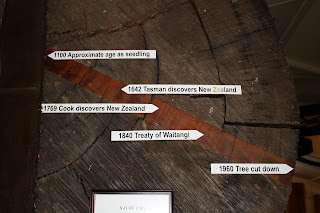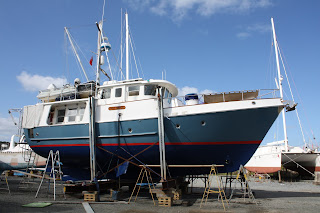We hauled out in Whangarei for the first time in almost two years. The last haul was in Trinidad in August 2009. She was in need of some attention and we decided to try Norsands Shipyard based on some quotes from other yards, talking with other boaters and the cleanliness of their bathrooms.
The haul out went smoothly enough despite not using a travel lift and slings that we were used to. They pre-measured the boat before we arrived and had the key dimensions and location of the Naiad fins all recorded. They pre-configured a cradle specifically for Emily Grace and were waiting when we arrived. I came along side a small dock and passed four lines ashore and with engine and man power, moved her in between the cradle arms.
Once positioned and tied tightly, we were pulled up the ramp with chain and rolled on massive steel and rubber wheels. Once pushed into a nice spot in the shipyard, the boat is blocked up level and the rolling cart is lowered and removed. The cradle will stay with the boat until we are re-launched.
This boatyard is quite clean and they even have us collect all our grey water (sinks and showers) into 5 gallon drums; which seems a little silly. When anchored in the river right off the shipyard, it is legal and commonplace to dump grey water directly overboard.
For the first time we did not sand and re-paint the bottom ourselves and hired out that work. We had several other jobs to do and frankly that is one of the worst jobs to do. The captain removed and re-sealed two portholes that had slow leaks underway and changed engine, Naiad and transmission oils and all the drive belts. We dropped and cleaned the keel cooler and treated the main engine with fresh long-life coolant to keep her happy.
Rebuilding heads (toilets) and replacing sewage hoses also were done with much grumbling from captain and crew. We removed the 400 feet of anchor chain, remarked our 25 foot markers and rotated the chain so that we will use the relatively unused section for the next several years. Most anchorages require less than 200 feet of chain. Kim did most of the work re-bedding all of the pilothouse windows that had been showing some minor leakage.
I threw a few more parts at the watermaker to keep it working and did a few minor repairs to the air conditioning units. We have enjoyed the cool temperatures here and the A/Cs will be needed in Fiji as we move closer to the equator again.
Kim did a few sewing projects; remade an integrated weight belt for my SCUBA (that dropped off when pulling the rig into the dingy), a cover for the outboard to protect it from the sun and even made a bug screen for our friends on Leu Cat. There is Malaria in Vanuatu and everyone is buttoning up screens and buying repellant here. We have the medication aboard, but the side effects can be as bad as the illness.
We had the paint crew here fix a poorly done waterline and Kim picked a nice red replacement color. With fresh new zincs, special paint on the props and navy blue bottom paint, she looks pretty good again. The Captain waxed the old blue paint above the waterline and she really looks good again. We are trying a special paint (Prop Speed) for the first time on the main and get-home props to reduce growth and improve efficiency underway. It looks gold and almost cost the same!
We rented a car for the entire haulout period since the yard is remote from the main town and we expected to need it for getting parts and re-provisioning the freezer with food. One day we drove 100 Km to the south and visited the Kauri Museum, but that will have to be a future post. We need to get back in the water.
Tom




































